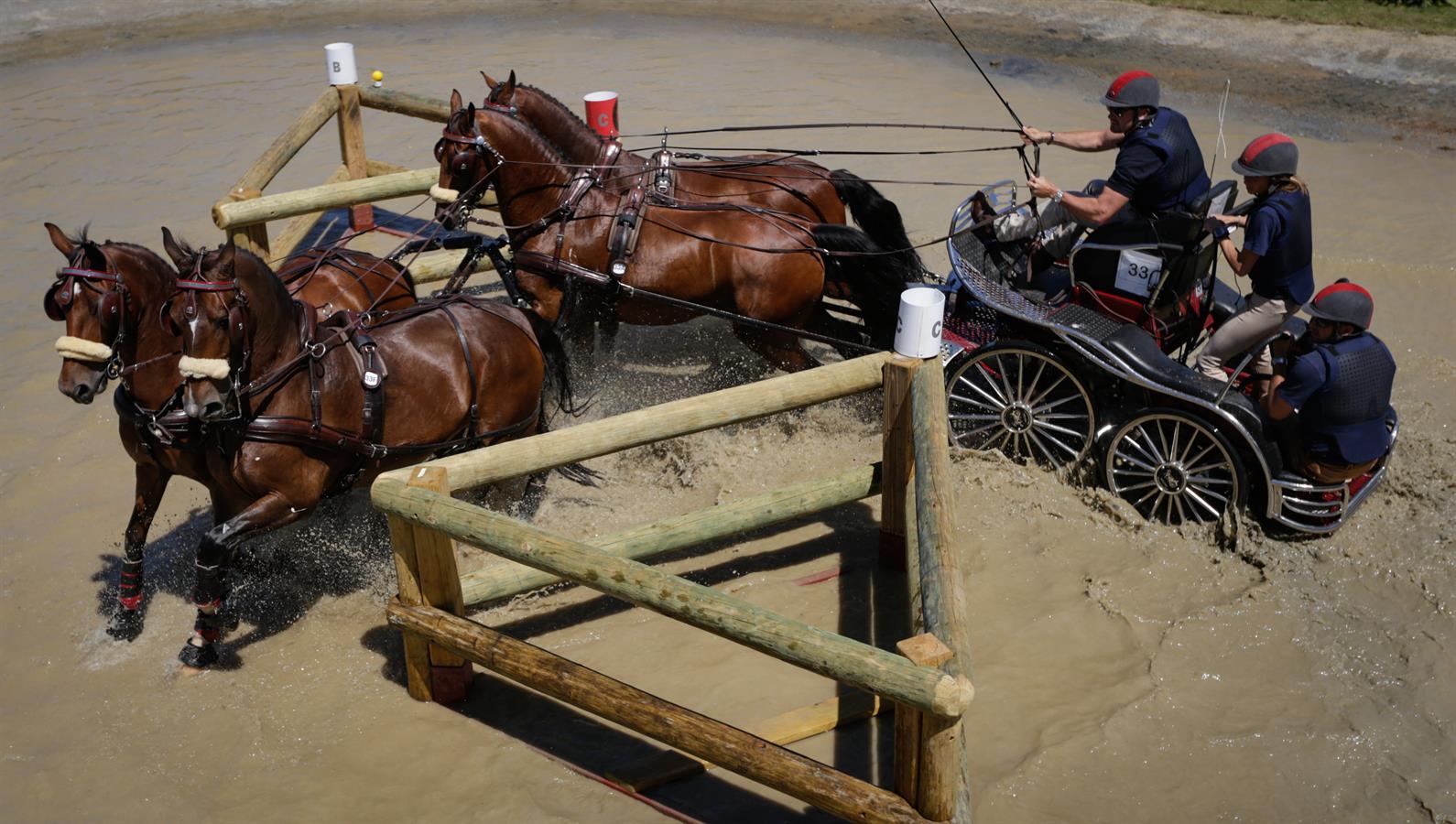Mill Spring, N.C. - I am originally from Norfolk, England where I worked for a carriage company doing horse drawn weddings. I came to America at 18 to complete an apprenticeship at a farm in Upperville, Virginia. I have been navigating on the FEI circuit for the past 13 years. I have been fortunate to navigate for many different competitors driving everything from a single, pair, and four- in-hand of ponies through to a four-in-hand of horses. My favorite being the horse fours! - Dee
The first time I stepped onto the back of a marathon carriage was in 2005. I was immediately hooked with the sport of combined driving! It is a three-day competition made up of dressage, marathon, and cones; very similar to that of the ridden discipline of eventing and just as exciting!
In the first phase, dressage, navigators are part of the overall picture, without playing an active role. They ride on the back of the carriage during this phase and are required to be seen, but not heard. There is no feeling quite the same as sitting behind four horses in complete harmony. The driver will have spent many months practicing the dressage test and the movements, seeking accuracy, impulsion, and obedience. The training involved in preparation for the dressage is fundamental for the basics needed for the marathon phase.
The navigator is perhaps the most utilized in the marathon phase of four-in-hand combined driving. A navigator has a variety of roles in the marathon phase, including planning a course with the driver, communicating verbally with the driver while on course, helping to counterbalance the carriage as it moves through the obstacles, and giving the driver overall confidence as he or she moves through this phase.
The marathon itself is comprised of three sections. Section A is used to help warm-up the horses and is a distance between five and eight kilometers. Then, there is a transfer section where the horses are allowed to cool, and navigators are able to make last-minute adjustments to the tack, carriage, etc.

Section B is where the fun begins! This section is a distance no greater than nine kilometers, with eight timed obstacles along the course. As navigators, we have spent hours walking these obstacles along with the drivers to pick our routes. The obstacles are gated A-F and must be completed in alphabetical order. The letters are flagged red and white, and to avoid course correction penalties and the dreaded elimination, the white letter must remain on the left and red on the right as the horses and drivers pass through the obstacles. Navigators are essential in assisting the drivers to formulate a plan for making it through the obstacles in a timely fashion and in the correct order. But, as with all good plans, they do not always go accordingly. Therefore, a plan B through X are often necessary.
One may notice different drivers will choose different routes through the obstacles. The shorter distance is not always the fastest, as it may mean slowing down to take a tight turn. One may also see knockdowns, or small balls, placed on top of posts within the obstacle. If knocked down, further penalties are incurred. Therefore, some drivers may choose a route with less risk. Choosing a route and deciding on certain turns may also be dictated by the experience of the horse in a particular position. Brave and forward moving horses need to be in the lead position. But the wheel horse needs to be strong and able to hold you out on the turns to prevent the carriage turning too quickly and hitting or becoming hung up in the obstacle and adding to the time.
All this being said, the feeling of four powerful horses galloping into an obstacle is a rush like no other! It truly takes a well-oiled team of horses and people to make the marathon phase go smoothly. A navigator needs to be able to communicate clearly with their driver. For instance, ‘no’ may sound like ‘go’ in the heat of the moment. The navigator often known as top step, works together with the person on bottom step to help the driver navigate through the course. The driver needs to have confidence that their top and bottom step will help keep all four wheels on the ground, or as we often refer to it, sunny side up. The marathon phase is definitely not a relaxing carriage ride around Central Park – it takes hard work and coordination between the navigators, the driver, and of course, the horses. I should also add that a good cheerful sense of humor is vital, along with an amazing ground crew that will be there at the end to tend to the horses and hose down the bottom stepper if the course has been particularly muddy.
The third phase and final test for the horses and their driver is the cones competition. This is also a test of memory for the driver as they memorize and prepare to drive the horses through the course. The cones can often change the leader board and either move a driver up onto the podium or knock a team out of the medals. The courses can be very technical and after asking the horses to gallop the previous day, we are now asking them to be subtle and responsive once again. The navigators role in the cones phase, as with dressage, is much more simplified. While their presence as a part of the team is required, they are not allowed to assist the driver with the course.
I hope you will tune in to the combined driving competition at the FEI World Equestrian Games™ Tryon 2018. The dressage phase will take place on Friday, September 21, with the marathon phase on Saturday, September 22, and concluding with the cones phase on Sunday, September 23. Cheer on the U.S. Combined Driving Team!


